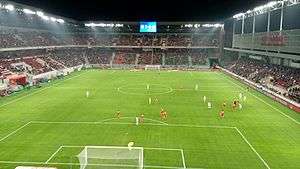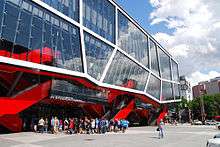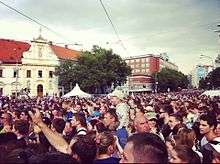Sport in Slovakia
Sport in Slovakia is influenced by its climate and geography; popular summer sports include football, tennis, volleyball, swimming, cycling and hiking, popular winter sports include skiing and snowboarding.[1] The most watched sports in Slovakia are football, ice hockey and tennis. The country features a typical post-Eastern Bloc system, where sport is being financed primarily from the state budget. In 2012, the state will pay 30,402,634 euro to over 7,500 different sporting clubs.[2]
Internationally, the most successful sport in Slovakia is ice hockey where currently, as of 2012, the country is ranked as the eighth best team in the world by the IIHF World Ranking.
History
Until revolution in 1989, the sport sector was highly centralized, oriented on a unified, nationwide programme of sports. In 1990 the Act No.173/1990 was adopted by the Federal Assembly of Czech and Slovak Federative Republic, which replaced the Act No. 68/1956 on Organisation Physical Education. Also in 1990, the National Council of the Slovak Republic approved the Act on Physical Culture No. 198/1990.
In 1997 the new Slovak National Council Act No. 288/1997 on Physical Culture was approved, which also included articles on educational and commercial activities in sport. By passing the Act on State Funding of Physical Culture No. 264/1993 the Slovak National Council approved financing of sport through lottery funds in 1993.
Description
In 2011, there were over 13,000 sporting clubs and 661,346 registered sportsmen in the country.[3] The most successful sporting club is Vojenské športové centrum DUKLA Banská Bystrica with 31 different medals in the year 2011.
Team sports
Football
For more information see Slovakia national football team.

| Football | |
|---|---|
| Country | Slovakia |
| Governing body | Slovak Football Association |
| National team | Slovakia |
| First played | 1898 |
| Registered players | 428,968 (2010)[4] |
| Clubs | 2,432 (2010)[4] |
National competitions | |
Club competitions | |
International competitions | |
Association football is the most popular sport in Slovakia, with over 400 thousand registered players. Since 1993, Slovak national football team has qualified only once to the FIFA World Cup or UEFA European Championship, in 2010, in which they proceeded into Play-offs, where they were defeated by Netherlands. The most notable result was the 3–2 victory over Italy.
In club competitions, only three teams have qualified to UEFA Champions League Group Stage, namely MFK Košice in 1997–98, FC Artmedia Bratislava in 2005–06 season and MŠK Žilina n 2010–11. FC Artmedia Bratislava has been the most successful team after finishing 3rd in Group Stage and therefore qualifying to Round of 32 of UEFA Cup. They also remain as the only Slovak club that has won a match in Group stage.
During Czechoslovak era the most notable result of a Slovak club was Slovan Bratislava's victory in 1968–69 European Cup Winners' Cup against FC Barcelona.
The most famous Slovak players are: Marek Hamšík, Martin Škrtel, Juraj Kucka, Peter Dubovský and Jozef Adamec.
Ice hockey
For more information, see History of ice hockey in Slovakia or Slovakia men's national ice hockey team.

.
| Ice hockey | |
|---|---|
| Country | Slovakia |
| Governing body | Slovak Ice Hockey Federation |
| National team | Slovakia |
| First played | 1920s |
| Registered players | 8,280[5] |
| Clubs | 820[5] |
National competitions | |
International competitions | |
After the dissolution of Czechoslovakia, Slovak national ice hockey team started competing in Group C (lowest tier) of IIHF World Championships. After winning Group C in 1994 and Group B in 1995 Slovakia was promoted to Group A for 1996 World Championship. Since then, Slovak hockey team has won one gold medal in 2002, two silver medals (in 2000 and 2012) and one bronze medal in 2003.
Slovakia has had many players in the NHL. From the Czechoslovak era, the most famous are Stan Mikita and Peter Šťastný. Since the Velvet revolution there have been much more Slovak players in the NHL, such as Peter Bondra, Marián Hossa, Pavol Demitra or Zdeno Chára. Up to now, there have been 9 Slovak players that have won the Stanley Cup:[6]
- Stan Mikita (1): 1961
- Jiří Bicek (1): 2003
- Martin Cibák (1): 2004
- Tomáš Kopecký (2): 2008, 2010,
- Miroslav Šatan (1): 2009
- Marián Hossa (3): 2010, 2013, 2015
- Zdeno Chára (1): 2011
- Michal Handzuš (1): 2013
- Marián Gáborík (1): 2014
In addition to the players in NHL, many Slovaks play in various leagues all over Europe, most of them in international KHL. As of 2012–13 season, there are 50 Slovak players playing in KHL, which is due to a Slovak team HC Slovan Bratislava competing in this league.
There are also three national hockey leagues in Slovakia, with Tipsport Extraliga being the top tier of the system. Most league titles (8) were won by HC Slovan Bratislava.
Slovakia also organized the 2011 IIHF World Championship, which was won by Finland. The venues were Bratislava and Košice and all matches attracted 406,804 visitors.
Ice hockey is probably the most popular sport in Slovakia. After finishing 2nd in 2012 IIHF World Championship a cheering crowd of tens of thousands people greeted the national team players on SNP Square in Bratislava,[7] which exemplifies the popularity of this sport in the country.

Rugby
Slovak Rugby Union is the official organization in Slovakia, to promote and organize the rugby. Based in Bratislava, competition are settled all around the country, divided by two types : rugby 7s and rugby XV. There are ten clubs in Slovakia, included Bratislava Rugby Klub, Trnava, Piestany, Bardejov, Kosice.
Individual sports
Whitewater slalom
Whitewater slalom is the most successful olympic sport in Slovakia with 10 gold, 2 silver and 4 bronze medals since 1993. Furthermore, Slovakia has won 43 medals (19—11—13) at World Championships, 69 medals (33—20—16) at European championships and 28 World Cups since 1993. The most famous athletes are Michal Martikán, Pavol Hochschorner/Peter Hochschorner, Ladislav Škantár/Peter Škantár, Elena Kaliská and Jana Dukátová.
Cycling
The best known Slovak cyclists currently competing are Peter Sagan and brothers Martin and Peter Velits. Sagan won three stages of the 2011 Vuelta a España, and at the 2012 Tour de France he won three more stages and the points classification. He repeated his victory in the points classification in the 2013 Tour and won another stage, and subsequently retained his points jersey in 2014, 2015 and 2016. He won the Road Race World Championship in 2015 and 2016. Peter Velits was classified second at the 2010 Vuelta a España after initial runner-up Ezequiel Mosquera was disqualified for a positive test for Hydroxyethyl starch. He and his HTC Columbia team also won the race's initial team time trial stage, and he won the race's individual time trial on stage 17.
Skiing
Veronika Velez-Zuzulová has been a top-ranked slalom skier since her emergence in the mid-2000s. She has twice finished third in the Alpine Skiing World Cup slalom standings: in 2008 and in 2013, a season in which she also scored two World Cup wins. She has since been followed by Petra Vlhová, who won the slalom at the 2014 World Junior Championships before taking her first World Cup race win in December 2015 in a slalom in Åre.[8]
Anastasiya Kuzmina has enjoyed success in biathlon. At the 2010 Winter Olympics she won a gold in the sprint and a silver in the pursuit. She successfully defended her sprint title at the 2014 Winter Olympics. She also won a silver medal in the mass start race at the 2009 World Championships and a bronze in the sprint at the 2011 Worlds. Martina Halinárová won a silver medal in the pursuit at the 1999 World Championships.
Slovak sports in world rankings
The table shows the most recent rankings of Slovak national teams in the most popular sports.
| Sport | Ranking | Rank | Nr. of countries | Updated | Link | ||
|---|---|---|---|---|---|---|---|
| Men | Women | Men | Women | ||||
| Football | FIFA World Rankings | 49 | 41 | 207 | 177 | 14 Feb 2013 | [9] |
| Ice Hockey | IIHF World Ranking | 6 | 7 | 47 | 36 | 2012 | [10] |
| Tennis | Davis Cup/Fed Cup Ranking | 33 | 5 | 130 | 95 | Feb 2013 | [11][12] |
| Handball | IHF Ranking | 14 | 14 | 46 | 45 | 2013 | [13] |
| Basketball | FIBA World Rankings | N/Aa | 37 | 81a | 73a | Sep 2012 | [14][15] |
| Volleyball | FIVB World Rankings | 26 | 57 | 122 | 112 | 23 Jan 2013 | [16] |
| Road Cycling | UCI World Tour Ranking | 13 | 65 | 20a | 66 | 12 Mar 2013 | [17] |
| Biathlon | IBU Nation Cup Scores | 12 | 10 | 40 | 40 | 2013 | [18] |
Notes
- a The countries have not scored any points are not on the list
See also
- Slovakia at the Olympics
- National sports teams of Slovakia
- History of Slovakia
- Economy of Slovakia
References
- ↑ "Slovakia and its Sports". Sportslovakia. Retrieved 31 August 2012.
- ↑ "Pravda o peniazoch pre šport: Štát nedodržiava vlastný zákon (The truth about finances for sports: The state is breaking its own law)". Nový Čas. 22 August 2012. Retrieved 31 August 2012.
- ↑ "KPMG - Koncepcia financovania športu (skratená verzia)" (PDF) (in Slovak). Slovak Olympic Committee. 2013-01-08. Retrieved 2013-06-04.
- 1 2 "Výprava SR na MS 2010" (in Slovak). Sports-info. Retrieved 12 March 2013.
- 1 2 "Základné údaje" (in Slovak). SZĽH. Retrieved 12 March 2013.
- ↑ Jakub Hlohoš. "Slovenskí víťazi Stanley cupu" (in Slovak). slovenskyportal.sk.
- ↑ "Slovenský národ povstal: Desaťtisíce ľudí vítali na námestí dojatých hokejistov!" (in Slovak). Topky.sk. 22 May 2012. Retrieved 13 March 2013.
- ↑ Dampf, Andrew (13 December 2015). "With Shiffrin out, Vlhova grabs 1st career win in slalom". news.yahoo.com. Retrieved 13 December 2015.
- ↑ "The FIFA/Coca-Cola World Ranking - Ranking Table". FIFA.com. 2015-12-01. Retrieved 2015-12-17.
- ↑ IIHF. "World Ranking". Iihf.com. Retrieved 2015-12-17.
- ↑ http://www.daviscup.com/en/rankings/current-rankings.aspx
- ↑ http://www.fedcup.com/en/rankings/current-rankings.aspx
- ↑ "Ranking Table". Ihf.info. Retrieved 2015-12-17.
- ↑ "FIBA World Ranking, men". FIBA.com. 2015-10-03. Retrieved 2015-12-17.
- ↑ "FIBA World Ranking, women". FIBA.com. 2015-10-03. Retrieved 2015-12-17.
- ↑ "Volleyball". FIVB. Retrieved 2015-12-17.
- ↑ "Union Cycliste Internationale". Uciprotour.com. Retrieved 2015-12-17.
- ↑ "Ibu Datacenter". Services.biathlonresults.com. Retrieved 2015-12-17.